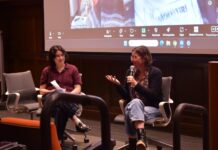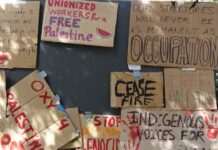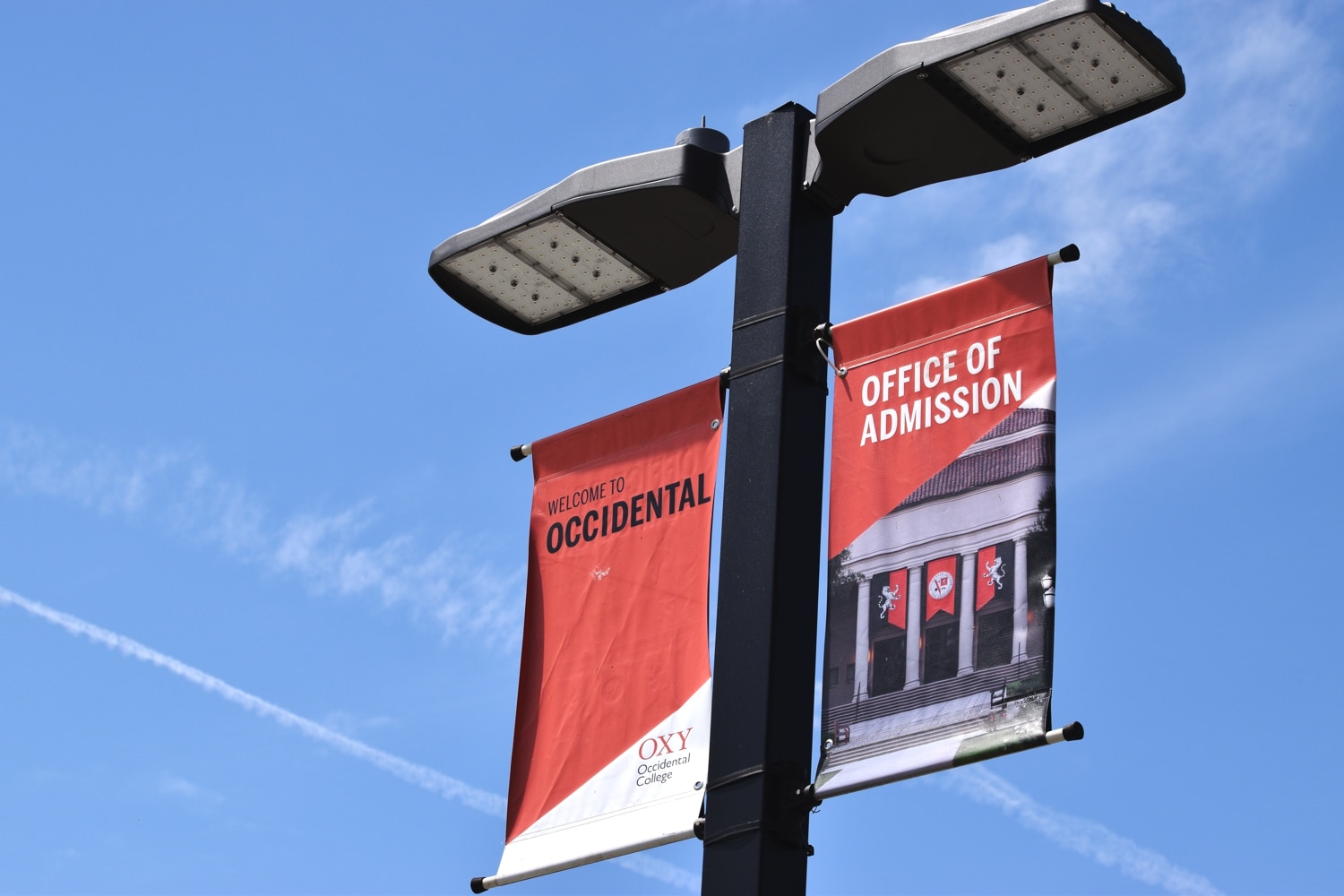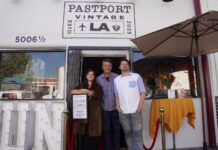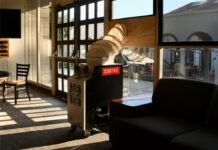
Since the first filming on campus in 1920 for the silent drama film “Cup of Fury,” Occidental’s beloved tree-lined quad and columned buildings continue to appear on big and small screens alike. Over the years, film icons have walked the same path as students walk on their way to economics class. In 2003, College Secretary and Voluntary Archivist Jean Paule compiled a list of motion pictures filmed on the campus, which is now available through Special Collections.
On the cover of Time Magazine’s August 1932 issue, four Marx brothers chuckle at the camera on Patterson field, filming “Horsefeathers.” Paramount’s “She Loves Me Not” brought “White Christmas'” Bing Crosby to the school in 1934, through which he gifted the “Tiger Song” to the college, which was written for the film and never used. Judy Garland, best known as Dorothy from “The Wizard of Oz,” shot her 1936 film debut on campus in “Pigskin Parade.” Jane Fonda, who recently spoke at the college last fall, debuted her acting career on campus in 1962’s “The Tall Story.” Ronald Reagan and Shirley Temple starred in “That Hagen Girl” in 1947.

Later on, the 1980s “Back to the Future” star Michael J. Fox filmed Disney’s “Midnight Madness” on campus, followed by the 1984 feature of the Gilman Fountain in “Star Trek III: The Search for Spock.” Ten years later, Cher and Dionne walked the quad in the 1995 romcom, “Clueless,” and the production crew of the teen drama series “90210” transformed Occidental into ‘California University.’
Since the 2000s, romcoms such as “The Holiday” in 2006 and “Made of Honor” in 2007 brought in Patrick Dempsey and Cameron Diaz. Most recently, Steve Carell stood outside Johnson Hall, transformed into a college in Italy, for Apple TV+’s “The Morning Show.” HBO’s “The Sex Lives of College Girls” has changed the campus into Vermont’s Essex College.
Filming Logistics
In 2014, Occidental contracted Unreel Locations to aid in bringing film crews to campus. Co-founders Peg Meehan and Joaquin Nunez said they have a niche part of the location management industry in representing educational institutions and museums and that this type of work is specific to a film-heavy location like LA.
“A location service represents the property, and basically we work as the agent — like an actor has an agent that gets jobs for them and negotiates their contacts — that’s what we do for properties,” Meehan said. “We do it for other properties besides Occidental, but we are known for representing colleges, universities, educational institutions [and] museums.”
According to Program Coordinator at Conference Services and Campus Filming Nicole Sullivan and Director of Catering and Conference Services Jonathan Steiner, Occidental keeps the full amount of charges for any additional or special services requested by production. They said the funds earned by Conference Services go into Occidental’s general operating fund, except for any additional or special services such as staffing Thorne Hall or removing outside banners.
“For example, staffing charges for Thorne Hall Auditorium get transferred to the Theater Department, and Facilities get transferred the fee for the banner removal,” Sullivan and Steiner said via email.
Part of Unreel’s work in the process is managing last-minute, evening or weekend inquiries that may come in and having strong relationships with both the college and the production companies. Meehan said they receive weekly reports of new projects coming up and then reach out to these companies to match them with one of their locations as part of their marketing program. If the production company is interested, they send scouts to the location.
“Scouting is when we bring the location person out, the director, the production designer, the cinematographer — there’s usually a number of scouts for them before they finalize that they want to film there,” Meehan said. “We have a complete file photo of the campus and the different buildings, we send that out to them up front based on what they want.”
Meehan said they work on a commission basis, and Unreel is allocated a specific percentage of the location fee paid to the college by the film’s producers.
Meehan said the turnaround times on filming have shortened recently due to shrinking film budgets, so having a close relationship with Occidental staff and knowledge of the campus is helpful.
According to Meehan, many companies like the columns on Fowler and Johnson Hall, and the most popular locations include the Arthur G. Coons stairs, Johnson Student Center quad, Choi Auditorium, Mosher and Fowler 302.

“If we ever can work [at Occidental], it’s usually their first choice,” Meehan said.
Once a production company decides to use Occidental’s campus, Unreel coordinates and manages the logistics and paperwork, including insurance, security deposits and contracts. Sullivan and Steiner work with Master Calendar to review campus events and activities on 25Live and put a temporary hold on locations while waiting for a contract, as well as communicating any information to relevant stakeholders.
“Once things are finalized between the production, the Oxy Conference Services communicates to campus about any parking impacts and if there are specific areas that need to be avoided,” Sullivan and Steiner said via email.
During the filming process, Unreel Locations has site representatives present every step of the way.
“[The site representatives are] there to make sure that they, you know, park only [in] the area that [is] designated for parking, and that everything is done according to the agreed upon contract and that they don’t do more, or if there are any changes, we can check with our contacts at Oxy to see if that’s possible,” Meehan said. “Afterwards, our site representatives there also make sure that everything is put back where it should be and cleaned up. We walk through with our Oxy staff and if there’s anything like, ‘These flowers got trampled by mistake,’ then we make sure they get replaced.”
Part of Unreel’s duties in this negotiation is to ensure the filming remains the least disruptive it can be.
“There’s no denying [it] — when a film crew is there, a film crew is there. They are kind of big, you might have noticed,” Meehan said. “But we try and keep them isolated in special areas.”
While students have been involved as extras in previous productions, such as “The Collegians” and “The College Hero” in 1927, Sullivan and Steiner said many production studios’ policies nowadays do not allow non-production staff to be involved in filming.
“If the production does allow for student shadowing […] [Media Arts & Culture] students can be involved,” they said via email. “Once Conference Services gets notified that the production will allow student shadowing, we notify the MAC Department, and they communicate directly with the MAC students.”
Sullivan said some of her favorite film projects shot at Occidental include “Clueless,” “Real Genius,” “Beverly Hills 90210” and “NCIS.” Steiner also specifically mentioned “Real Genius,” a science fiction comedy film.
“[My favorite is] the ’80s classic Real Genius (1985) with Val Kilmer! I love that it was filmed at Oxy — it brings back childhood memories, and certain parts of campus like the Cooler still have that awesome ’80s vibe,” Steiner said via email. “Oxy feels both nostalgic and current at the same time.”
Meehan said that while filming can sometimes be inconvenient for students, she hopes they enjoy watching the production when it airs.
“When you’re looking something up on a website and you say, ‘Oh, there’s Oxy!’ or you could be looking at reruns of an older show, and you go, ‘Oh, wait a minute, there’s my college!’ […]” Meehan said. “It is fun watching the television shows or movies or even the commercials when you see the final product, and I hope everybody at Oxy feels the same way about that.”
Anywhere, USA
A few months ago, Special Collections Archivist Alanna Quan found herself walking down Occidental’s quad on a sunny day. What she saw, she said, was a young girl roller skating backward with headphones on, friends laying out on the grass and throwing frisbees across the paved walkways.

“It really did look like the stereotype, in the positive sense, of what LA looks like and what college life looks like. Students on the grass talking to each other, people walking through the quad,” Quan said. “You couldn’t cast it better, and that’s just everyday life.”
Quan said the architectural style of the college is not only iconic of its era, but that it came from a time in the early 1900s when many major institutions were being built.
“The teens through, I’d say, the mid-30s is a lot of the time when they were building schools that looked like this and banks that looked like this and colleges that looked like this all across the country,” Quan said. “There’s something about Oxy’s architecture that speaks to what people think a college looks like, or a bank, or a high school. Which is probably why we get a lot of school-based [films].”
Meehan said the architectural style is not defined by any specific region, which lends itself to the transformation into colleges set in Vermont, Italy or anywhere else.
“Occidental has a beautiful quad, they have beautiful buildings that don’t scream Southern California, they don’t scream the South, they actually can be ‘Anywhere, USA,’” Meehan said. “Occidental has been filmed — besides a general fictitious college, which TV shows do a lot — it’s been NYU, it’s been Berkeley, Yale, the Naval Academy, some Historic Black Colleges.”
Nunez said the look of the main quad, particularly, gives a very strong college look.
“We do a lot of car commercials or Best Buy back-to-school commercials,” Nunez said. “The idea of that is that the parent is dropping off the kid at school […] you’re on the quad and it looks like you’re in a college.”
Quan said this phenomenon of attraction for filming is like the ‘chicken or the egg’ dilemma.
“Is it because it’s in the movies that that’s what [our image] looks like, or is it because that’s what it looks like that the movies want to be here?” Quan said.
Defining the ‘social imaginary’
The use of Occidental’s campus in film productions helps to build viewers’ collective vision of the world, whether watching Cher attend Bronson Alcott High School or the cast of “Criminal Minds” solve a college student’s murder. Visiting Assistant Media Arts & Culture (MAC) Professor John Trafton teaches and investigates the relationships between film and history — including how film writes history and tells stories about the past — and how other art and cultural forms shape film.

“Part of what I’ve looked at with my work is how Los Angeles, and different parts of Los Angeles, have had their own social imaginaries constructed through film and how film interacts with a constellation of different art forms like painting, photography, tourism, architecture,” Trafton said. “In the case of Oxy, for example, it doesn’t really surprise me that it would be such an ideal filming location for universities.”
Trafton said this social imaginary is part of how our collective vision of concepts is created and evoked.
“Since the beginning of the 20th century, film has shaped what scholars refer to as the social imaginary of places, people [and] time periods,” Trafton said. “The social imaginary is a set of images that are conjured up in our mind when we hear certain words or phrases, or encounter certain image types of visual motifs.”

As for the use of Occidental’s campus in film, Trafton said it provides a vision of an educational experience that does not reflect what the majority of students actually get to experience, especially those in underserved areas.
“It reflects this very idealized educational environment in films and television shows,” Trafton said. “It’s not a very accurate depiction, and it’s worth wondering and maybe critically interrogating why that is — it’s a fantasy.”
Beyond the campus itself, Quan said the frequency of filming in Northeast LA sets a vision often for the ‘average American’ lifestyle.
“When you think of ‘city,’ you’re going to think of the New York City skyline. That’s sort of like any city. When you think of anybody’s middle-class town, you’re going to end up thinking about what Northeast LA actually looks like,” Quan said. “Oxy being one of the oldest institutions of this type in Northeast LA is [some] of why Oxy is a big part of that ‘What does it mean to be American?’”
Quan said the demographics shown living or attending these film settings are not those you would see in real life — college students or couples in their early 20s living in million-dollar homes, for example — and this speaks to a dichotomy between values and lifestyle.
“I can’t help but believe that it informs how American culture conceives [of] the middle-class lifestyle — the promise of the American dream that we’re all supposed to be able to achieve if we work hard enough,” Quan said.
Contact Mollie Barnes at mbarnes@oxy.edu
![]()


